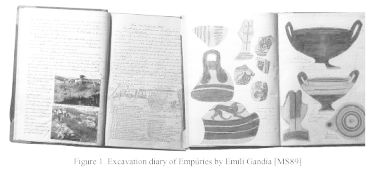Abstract
Computer Science and Artificial Intelligence are technologies and
research topics applied to multiple domains. The goal of this paper
is to explore which of the new topics of Artificial Intelligence
can be applied in the future to Archaeology. The aim is not to give
solutions to archaeological problems, but to present three new areas
that can be useful to it:
Knowledge Discovery in Databases (KDD), Visual Information Management
(VIM) and Multi-agent Systems (MAS).
Introduction
Early in this century, only privileged people—who had the time,
the money and the intellectual curiosity—could be working in
archaeology. We can say that archaeology was for erudite people,
everyone being an expert on his knowledge area. Excavation diaries
are an example of information gathering used then (see Figure 1).

They consisted of natural language explanations of the works and
circumstances of the excavation, besides photographs and drawings
of the discovered materials.
After that, as a result of the development of archaeology, information
gathering in the excavations was performed in a more systematic
way. The system used was based on record cards. For every object
or structure found, a record card was filled with some slots or
attributes more or less well defined, and natural language descriptions,
photographs and drawings. There are still thousands of manual records
cards.
Continua >>>>>